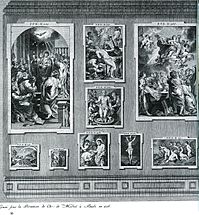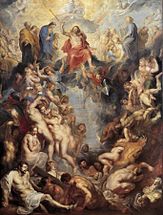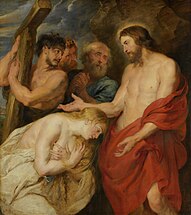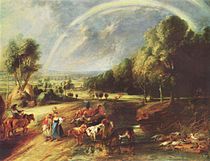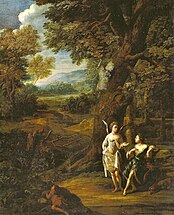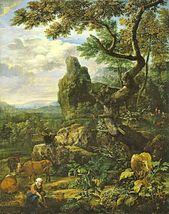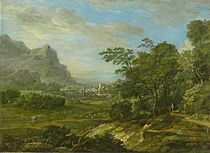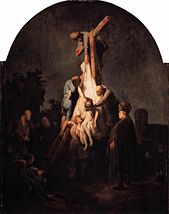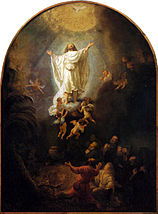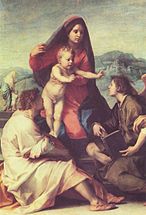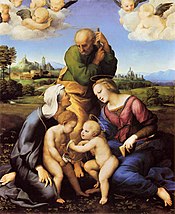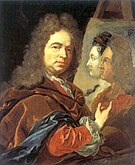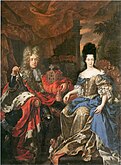Gemäldegalerie Düsseldorf

The Gemäldegalerie Düsseldorf was a world-famous collection of paintings with a focus on Italian , Flemish and Dutch painting of the Renaissance and Baroque , enriched by Dutch- German and Italian- Venetian works. The gallery électorale ( German electoral gallery ) was initially only referred to as the three-wing gallery building on the south side of the Düsseldorf palace , one of the earliest independent museum buildings in Europe , with reference to the galleria of the Uffizi in Florence . The collection of paintings exhibited there on two floors was considered to be “an exquisite collection for the proportions and quality of the time” and a “grandiose picture treasure”, “art treasure of European standing”, as the “German Louvre ”. The collection, which comprises over 1000 exhibits, is now scattered around the world. About 50 paintings are still in Düsseldorf in the Museum Kunstpalast ; many pictures formed the basis of the Munich Pinakothek .
Denis Diderot , Aurelio de 'Giorgi Bertola , Jakob Jonas Björnståhl , Georg Forster , Goethe , Johann Caspar Füssli , Montesquieu , Anna Amalia von Sachsen-Weimar-Eisenach , Johann Georg Sulzer , Johann Gottfried Herder , Alexander and Wilhelm von Humboldt , Thomas Jefferson , Angelika Kauffmann and Clemens Brentano , Paul of Russia and the later French kings Louis XVIII. and Karl X. had visited the gallery. Thomas Rowlandson described it as "one of the best picture galleries in all of Europe". The gallery functioned as a social meeting point for socializing and conversation for the nobility and the upper middle class .
Gallery building
The two-story building was located on today's Burgplatz in Düsseldorf's old town , on the south side of the Düsseldorf Palace . Originally there was a direct connection with the electoral apartments of the palace. Parts of the building structure of the east wing of the gallery are preserved in a wing of the Düsseldorf city hall .
History of the collection
The roots of the first area of the collection lie in the Electoral Collection of Johann Wilhelm von der Pfalz , who expanded the small collection that he found in Düsseldorf with his second wife, the née Princess Anna Maria Luisa de 'Medici , and created a separate exhibition building for them let create. As the initiator of the Art Gallery of the Dutch portrait painter applies Jan Frans van Douven that from 1684 for the Elector as art agent was traveling and in 1700 rose to become superintendent of the electoral art collection. The gallery suffered a first bloodletting when Anna Maria Luisa withdrew her inheritance from the collection after the death of her husband and returned to Florence with it in 1717 . Throughout the 18th century, the picture gallery was a famous sight that attracted people from far away. In 1776/1777 the writer Wilhelm Heinse celebrated his literary breakthrough after he had written about some paintings in the Düsseldorf gallery in Teutscher Merkur . He wrote to Johann Wilhelm Ludwig Gleim :
“Here we have a collection of paintings, of which no place in Germany can boast, not even Dresden; and if a city in Greece was already famous for a statue or a painting by one of its great masters: what should Düsseldorf not be throughout Europe if art was still so valued and honored? The English countries, too, and the first humans, regardless of all their bad habits, travel here in large numbers just to look at them. (...) The collection is not as numerous as others, but it contains the more masterpieces; (...) Palatinate is a happy country, and the banks of the Rhine offer the muses who go astray in many other areas a charming and safe stay. "
In 1795, during the First Coalition War , the art treasures were brought to Mannheim because of the approaching French revolutionary army . After the Treaty of Lunéville , the estates of the Duchy of Berg arranged for the picture gallery to be returned. After the Treaty of Brno, the Peace of Pressburg and the Treaty of Schönbrunn there was an exchange of countries between the Kingdom of Prussia , Electoral Palatinate-Bavaria and France in 1805/1806 A few months later, the Rhine Confederation was to be elevated to the Grand Duchy of Berg , left to Napoléon Bonaparte . Before that, however, Kurpfalz-Bayern, which rose to the Kingdom of Bavaria through the diplomacy of Maximilian Joseph , instructed its authorities to bring the collection of the Düsseldorf gallery to Kirchheimbolanden Castle . The collection was later brought from there to Munich as if it were a private property of the Bavarian crown. On the other hand, the legal standpoint in Düsseldorf was that the collection should be constitutionally considered public property of the state, i.e. as state property of the Duchies of Jülich-Berg or the Duchy of Berg , then as a legal successor to the Grand Duchy of Berg and the Kingdom of Prussia , and that therefore there is a right to return.
Forces in Düsseldorf tried in various ways to get the collection back. After the German War , which the Kingdom of Bavaria lost on the side of the Austrian Empire against Prussia and its allies in 1866, the city and the Rhenish provincial parliament pushed for the return of the picture gallery as a condition for a peace treaty. The matter dragged on, however. Due to the state treaty between Prussia and Bavaria in 1870 , in which Prussia preferred to receive other concessions from Bavaria, Düsseldorf finally had to forego the return of the transferred electoral collection of paintings. The collection that remained in Bavaria is now the core of the Munich Pinakothek . The value of the collection was then estimated at 2,100,000 thalers. Düsseldorf then submitted a petition to Kaiser Wilhelm I in 1872 in order to receive compensation for the lost gallery holdings. The emperor granted the request and granted a relatively modest sum of 150,000 thalers for the construction of a new art gallery . As a result, this art gallery was one of the first museums in Germany to be exclusively dedicated to the collection and exhibition of contemporary art.
Without the gallery, the art academy that is so important for Düsseldorf would not have come into being. Born the son of a civil servant and trained as a painter in Rome, Wilhelm Lambert Krahe became director of the Düsseldorf gallery in 1756 on the recommendation of the art-loving Cardinal Alessandro Albani . Around 1762 Krahe founded a drawing school, possibly based on the model of the drawing school founded by Peter Anton von Verschaffelt in Mannheim in 1758 and, in connection with the Krahe, the task of creating ceiling paintings in Benrath Palace . From the drawing school Krahes emerged in 1773 the "Electoral Palatinate Academy of Painters, Sculpture and Architecture", around 1800 the Academy of Fine Arts , and in 1819 the Düsseldorf Art Academy, which was held in the palace and gallery until 1872, the year of the last Düsseldorf palace fire was housed and acquired an international reputation with the Düsseldorf School of Painting . Gallery inspector was Joseph Brulliot in 1760 , who was a teacher of painting at the Academy of Fine Arts in Düsseldorf and was transferred to Munich as an inspector at the Bayerische Gemäldegalerie in 1807 . In 1801 he was succeeded in the office of gallery director by Johann Peter Langer , director of the Electoral Palatinate Academy , who also moved to Munich in 1806 after the majority of the collection had been removed from Düsseldorf on the orders of the sovereign and brought to Munich via Kirchheimbolanden.
description
The stock includes over 100,000 paintings, sculptures, drawings, graphics, photographs, arts and crafts exhibits and glass objects. The gallery was divided into four classes. The first showed 50 paintings by Peter Paul Rubens , including the “Last Judgment” . The second showed works by the most famous Flemish painters such as Anthony van Dyck . The third showed works by the Dutch painter Adriaen van der Werff , the fourth and largest presented works by Raffael , Giulio Romano , Guido Reni , Titian , " Paul Veronese ", Antonio da Correggio , " Franz Albano ", Rubens, van Dyck, Rembrandt . The gallery was furnished with marble and bronze statues, taken after Italian models.
46 paintings by Peter Paul Rubens alone were in the picture gallery. In addition 21 works by Anthony van Dyck, by Jan Brueghel the Elder. Ä. as well as Italian painters such as Annibale Carracci , Michelangelo and Leonardo da Vinci . The picture gallery also included the work “Homage to the Arts” by Adriaen van der Werff, which was one of four paintings to return to Düsseldorf from Munich, still lifes by Rachel Ruysch and Eglon Hendrick van der Neer , works by Dutch painters from around 1700 such as Herman van der Mijn , Coenraet Roepel , Gerard Hoet and Gerard de Lairesse , further works by Paul Bril , Hans Rottenhammer and Adam Elsheimer as well as works by Venetian painters such as Antonio Bellucci , Giovanni Antonio Pellegrini , Domenico Zanetti .
Around 50 paintings from the electoral picture gallery can be admired in Düsseldorf today, including three of the works from the Alte Pinakothek , which originally belonged to the Düsseldorf picture gallery and are on permanent loan to the museum's collection: Assumption of Mary and Venus and Adonis by Peter Paul Rubens , as well as Samson and Delilah by Joos van Winghe .
Nicolas de Pigage , the architect of Benrath Palace, presented the gallery's paintings in a magnificent catalog in 1778 . These were represented by copper engravings, made by Christian von Mechel from Basel. The paintings were arranged according to halls and walls.
- View of the electoral gallery in the Düsseldorf City Palace, based on copper engravings in the magnificent catalog from 1778
Room 5, wall 3 with seven paintings by Rubens including "Last Judgment"
- School of Adriaen van der Werff
- Peter Paul Rubens
Assumption of Mary , today the Museum Kunstpalast
Christ and Mary Magdalene
Defeat Sennacherib
- Eglon van der Neer
Shepherd scene , 1698
- Other painters
Samson and Delila by Joos van Winghe
Minerva, Mercury and Plutus pay homage to the Electress Anna Maria Luisa de 'Medici , presumably by Antonio Bellucci
The Adoration of the Child by the Shepherds by Rembrandt van Rijn , 1646
Madonna with the Christ child standing, Saint Mark and angels by Andrea del Sarto , between 1520 and 1530
The Fire of Troy by Adam Elsheimer , 1600 or 1601
The Holy Family in a wreath of flowers and fruits by Jan Brueghel the Elder and Pieter van Avont, around 1620 to 1623
The Holy Family with Saints Elizabeth and John the Baptist by Raphael , ca.1506
Assumption of the Virgin by Guido Reni , 1642
The Quack by Gerard Dou , 1652
- Jan Frans van Douven
Duke Johann Wilhelm von Pfalz-Neuburg with his first wife, Maria Anna Josepha of Austria
literature
- Sabine Koch: The Düsseldorf picture gallery . In: Bénédicte Savoy (ed.): Temple of Art. The birth of the public museum in Germany 1701–1815 . Böhlau Verlag, Cologne 2015, ISBN 978-3-412-22251-2 , p. 151 ff.
- Anton Fahne : The Düsseldorf museum building . Düsseldorf 1876 ( digitized version )
- museum kunst palast, Düsseldorf. With contributions by Bettina Baumgärtel , Sonja Brink, Christoph Danelzik-Brüggemann, Jean-Hubert Martin, Helmut Ricke, Dieter Scholz, Barbara Til, Stephan von Wiese. Book series by the BNP Paribas Foundation. Paris 2003, ISBN 2-7118-4673-3 (German, also French and English editions)
Web links
Individual evidence
- ^ A b c Karl Bernd Heppe: The Düsseldorf cityscape I. 1585–1806. Düsseldorf 1983, (picture booklets of the Stadtmuseum Düsseldorf No. 4) p. 38.
- ^ Thomas W. Gaehtgens , Louis Marchesano: Display and Art History: The Düsseldorf Gallery and Its Catalog . Getty Publications, Los Angeles 2011, ISBN 978-1-60606-092-6 , p. 81 ( limited preview in Google Book Search)
- ^ La Galerie électorale de Dusseldorf (…) , magnificent catalog by Nicolas de Pigage, 1778, title recording of the University and State Library in Düsseldorf
- ^ Ekkehard Mai : The Düsseldorf Art Academy in the 19th Century - Cornelius, Schadow and the consequences . In: Gerhard Kurz (Hrsg.): Düsseldorf in the German intellectual history . Schwann-Bagel Verlag, Düsseldorf 1984, ISBN 3-590-30244-5 , p. 197
- ↑ a b When Florence approached the Rhine with a detailed description of the picture gallery
- ^ Otto Pöggeler : Downfall and new beginning on the Rhine. Düsseldorf and the West German centers in the period of upheaval around 1800 . In: Gerhard Kurz (Hrsg.): Düsseldorf in the German intellectual history . Schwann-Bage Verlag, Düsseldorf 1984, ISBN 3-590-30244-5 , p. 21
- ↑ Jutta Hoffritz: The last Medici . In: Die Zeit , No. 46/2008
- ↑ The fine arts . duesseldorf.de; Retrieved October 20, 2014
- ^ Klaus Müller: Under Palatinate-Neuburgian and Palatinate-Bavarian rule. In: Hugo Weidenhaupt (Ed.): Düsseldorf. History from the origins to the 20th century. Schwann in Patmos Verlag, Düsseldorf 1988, ISBN 3-491-34222-8 , p. 253
- ↑ Georg Forster: Views of the Lower Rhine, Brabant, Flanders, Holland, England and France , Part One, Chapter VI. to VIII. Düsseldorf .
- ^ Campaign in France 1792 in the Pempelfort section , November 1792. ( gutenberg.org )
- ^ Leonhard Meister: Helvetiens famous men , Volume 1, Zürich / Winterthur 1782, p. 145 ( digitized in the Google book search)
- ↑ Thomas W. Gaehtgens: On the way to art history. Pigages and Mechel's catalog for the Düsseldorf Gemäldegalerie . In: Gudrun Swoboda (Hrsg.): The imperial picture gallery in Vienna and the beginnings of the public art museum . Volume II of European Museum Cultures around 1800 . Böhlau Verlag, Vienna, Cologne, Weimar 2013, p. 479
- ↑ Johann Georg Sulzer : General Theory of Fine Arts , MG Weidmanns Erben and Reich, Leipzig 1775, Part Two (K to Z), p. 294 ( digitized in the Google book search)
- ↑ Gustav Prümm: A "gain for life". The Düsseldorf picture gallery of Elector Johann Wilhelm von der Pfalz . Books on Demand, Norderstedt 2009, ISBN 978-3-8370-9115-1 , p. 144
- ↑ Jürgen Overhoff: An emperor for America . In: Die Zeit , No. 45/2012, p. 3: Enemy meetings in Frankfurt am Main
- ↑ Gilbert Chinard: Thomas Jefferson: The Apostle of Americanism , first published 1929, The Floating Press, 2011, ISBN 978-1-77545-593-6 , p. 189 - "... the gallery of paintings is sublime ...".
- ^ Karl Leopold Strauven : About artistic life and work in Düsseldorf to the Düsseldorf painter school under director Schadow. Hofbuchdruckerei H. Voss, Düsseldorf 1862, p. 38
- ^ Letters from Clemens Brentano between November 15, 1802 and January 10, 1803, published in: Beatrix Müller, Marianne Tilch (Ed.): Düsseldorf. Texts and images from four centuries. JBMetzlersche Verlagsbuchhandlung, Stuttgart 1991, ISBN 3-476-00784-7 , p. 119 ff.
- ^ Johann Wolfgang von Goethe: Campagne in France 1792 , 1822. In: Beatrix Müller, Marianne Tilch (Ed.): Düsseldorf. Texts and images from four centuries . JB Metzlersche Verlagsbuchhandlung, Stuttgart 1991, ISBN 3-476-00784-7 , p. 107
- ↑ Carmen Götz: “We live in our Pempelfort ... like Diogenes in a barrel; only with the difference that we are cleaner and more sociable ”: Friedrich Heinrich Jacobi and the conviviality in the“ Pempelforter Kreis ” . In: Peter Albrecht, Hans Erich Bödeker, Ernst Hinrichs (Eds.): Forms of Sociability in Northwest Germany 1750-1820 (= Wolfenbütteler Studies for the Enlightenment, Volume 27), ISBN 3-484-17527-3 , p. 205 ( limited preview in Google Book Search)
- ^ Bettina Baumgärtel : Dutch Paintings and Collections . In: Ekkehard Mai (ed.): Holland after Rembrandt. On Dutch art between 1670 and 1750 . Böhlau Verlag, Cologne 2006, ISBN 978-3-412-07006-9 , p. 38
- ↑ Quoted from: Beatrix Müller, Marianne Tilch (Ed.): Düsseldorf. Texts and images from four centuries. JBMetzlersche Verlagsbuchhandlung, Stuttgart 1991, ISBN 3-476-00784-7 , p. 60 f.
- ^ JF Wilhelmi: Panorama of Düsseldorf and its surroundings. JHC Schreiner'sche Buchhandlung, Düsseldorf 1828, p. 87
- ^ Peter Hüttenberger: The development to the big city up to the turn of the century. In: Hugo Weidenhaupt (Ed.): Düsseldorf. History from the origins to the 20th century. Schwann in Patmos Verlag, Düsseldorf 1988, ISBN 3-491-34222-8 , Volume 2, pp. 581 f.
- ^ Georg Friedrich Koch: Museum and exhibition buildings . In: Eduard Trier, Willy Weyres (Ed.): Art of the 19th century in the Rhineland . tape 2 . Architecture: II, secular buildings and urban planning . Schwann, Düsseldorf 1980, ISBN 3-590-30252-6 , pp. 212 f .
- ^ Theodor Levin: Contributions to the history of artistic efforts in the house of Pfalz-Neuburg . (PDF) In: Contributions to the history of the Lower Rhine. Yearbook of the Düsseldorf History Association. Volume 19 (1905), pp. 160 ff. (616); Retrieved from the ia600405.us.archive.org portal on December 25, 2013
- ↑ According to other information, Cardinal Silvio Valenti Gonzaga had made the recommendation in 1755. - Cf. Karl Leopold Strauven: About artistic life and work in Düsseldorf to the Düsseldorf painter school under director Schadow. Hofbuchdruckerei H. Voss, Düsseldorf 1862, p. 39.
- ↑ Klaus Müller, p. 267
- ↑ Brulliot, Joseph August; 1739-1827; Father of Franz Brulliot; Places of activity: Düsseldorf and Munich; History painter (PND 129365629) , on Digital Library - Munich Digitization Center
- ↑ smkp.de
- ↑ Information on the collection at museum-kunst-palast.de; Retrieved October 20, 2014




